
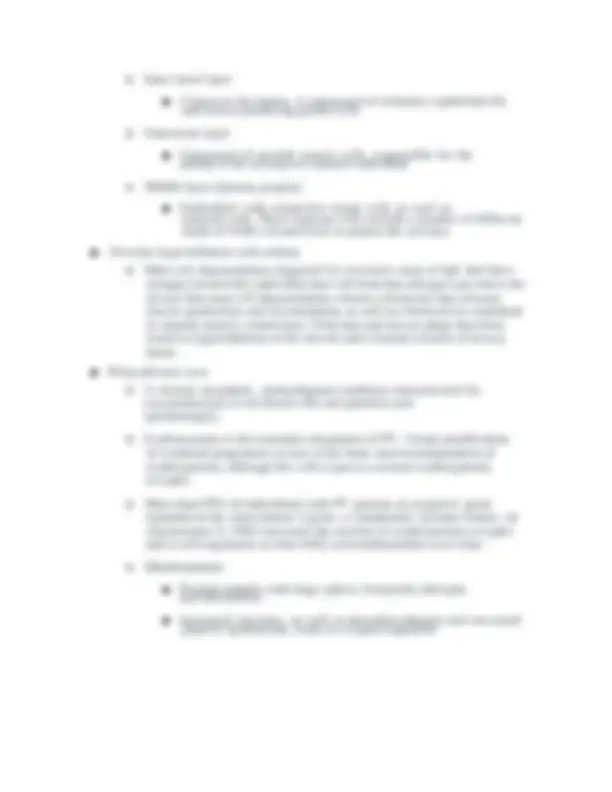
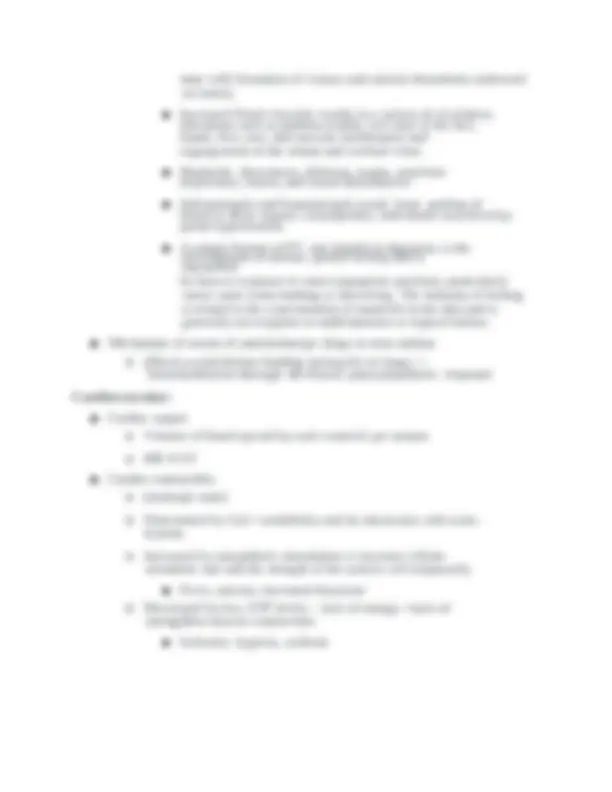
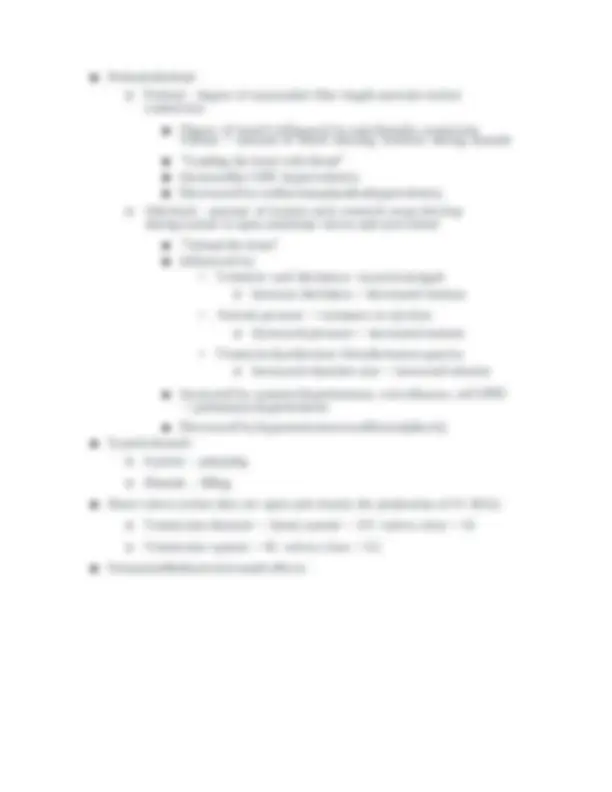
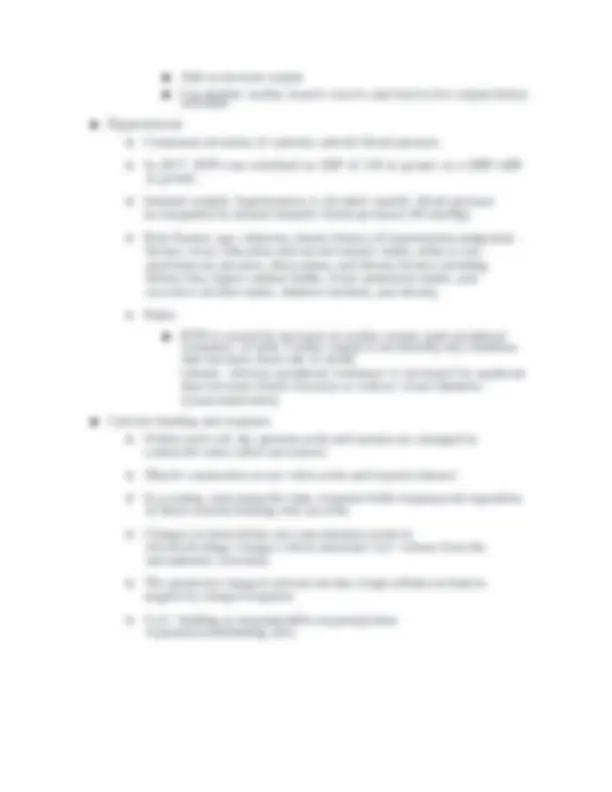
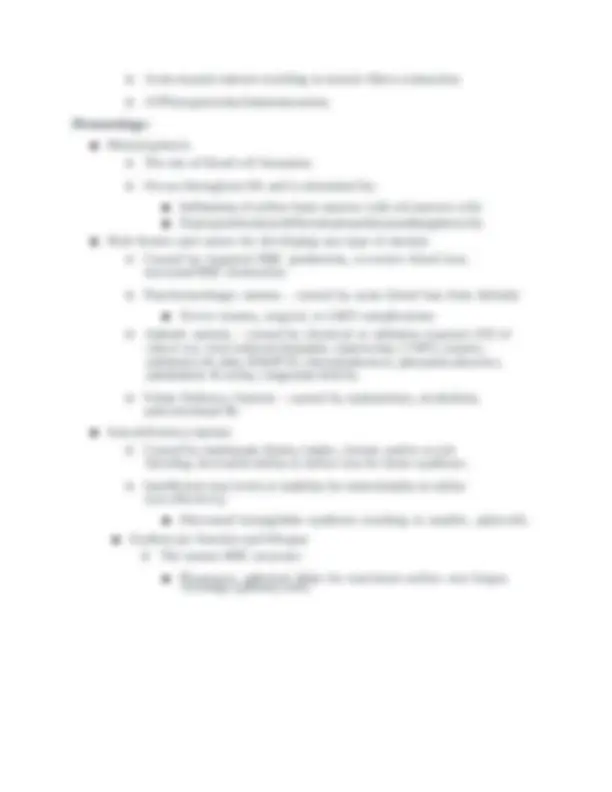
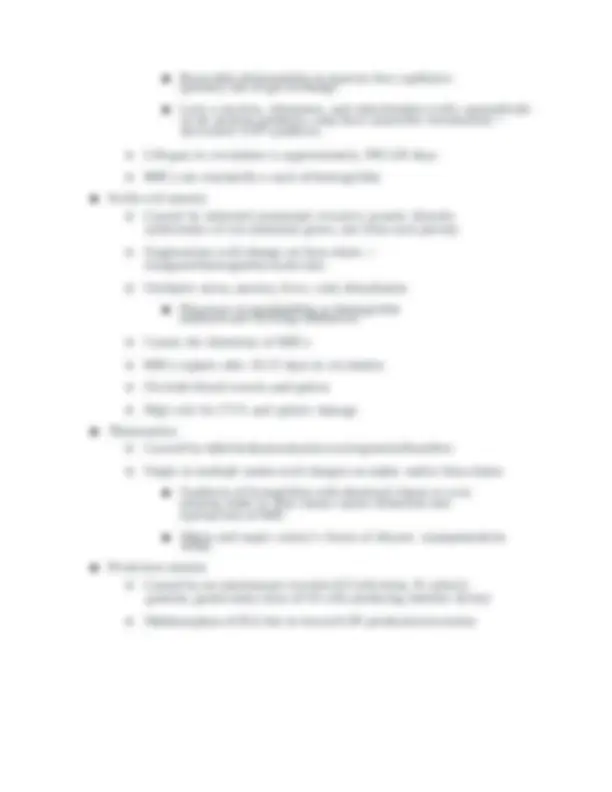
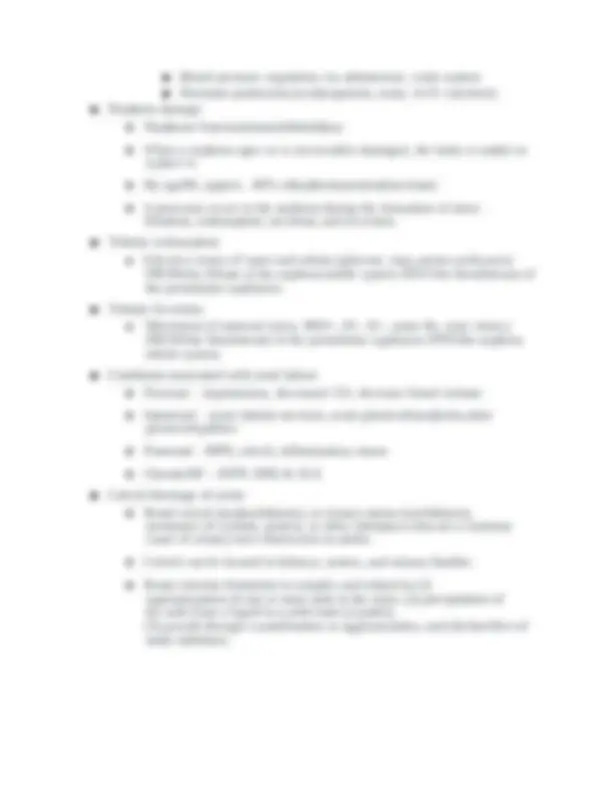
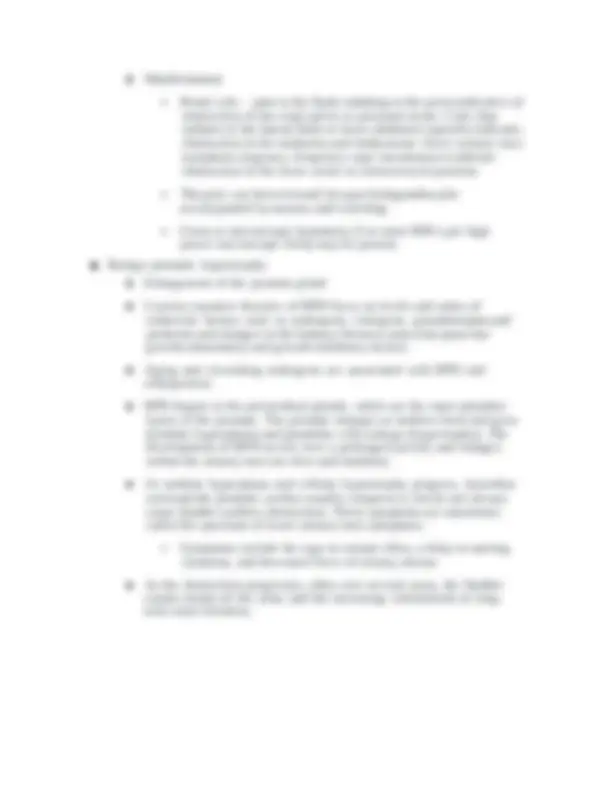
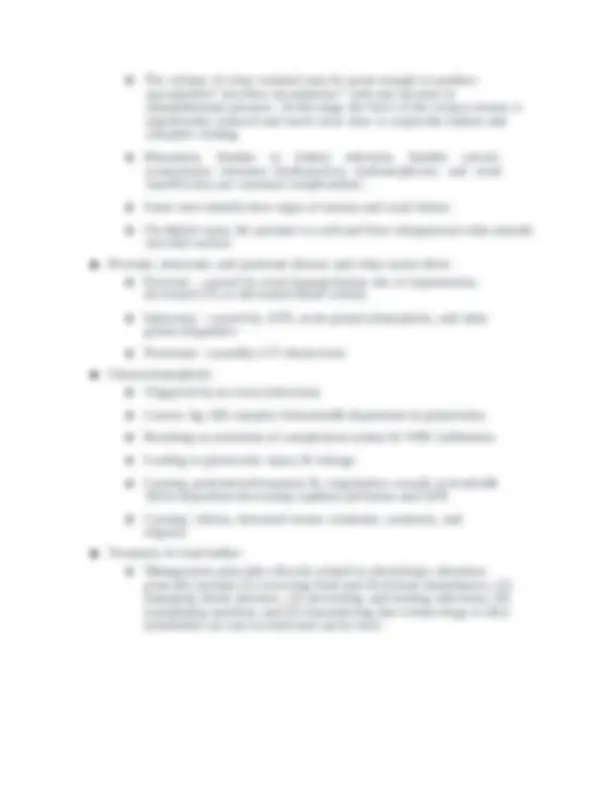


Study with the several resources on Docsity

Earn points by helping other students or get them with a premium plan


Prepare for your exams
Study with the several resources on Docsity

Earn points to download
Earn points by helping other students or get them with a premium plan
Community
Ask the community for help and clear up your study doubts
Discover the best universities in your country according to Docsity users
Free resources
Download our free guides on studying techniques, anxiety management strategies, and thesis advice from Docsity tutors
A study guide for the NR 507 Advanced Pathophysiology Midterm exam. It covers various topics related to pulmonary pathophysiology, including anticholinergic drugs, asthma treatment, bronchitis, acid/base disturbances, heart valves, heart failure, and anemia. The guide provides a list of questions and answers that can help students prepare for the exam. It also includes definitions, explanations, and examples of different concepts related to pulmonary pathophysiology.
Typology: Exams
1 / 16

This page cannot be seen from the preview
Don't miss anything!










Pulmonary: ▪ Review concepts related to anticholinergic drugs and the treatment forasthma o (Block acetylcholine binding (primarily in lung) -> bronchodilation through decreased parasympathetic response ▪ Tiotropium, Ipratropium o Short-actingbeta-adrenergicagonists(SABA)– activatebeta receptors primarily in the lung -> bronchodilation through increased sympathetic response ▪ Albuterol o Oral corticosteroids – inhibit inflammatory cells and chemical production -> reduce inflammatory process ▪ Prednisone, prednisolone, methylprednisolone o Long acting: ▪ Inhaled corticosteroids
mucous glands and goblet cells in the airway epithelium, smoothmuscle hypertrophy with fibrosis, and narrowing of the airways. o Hypersecretion of thick, tenacious mucus occurs and cannot be cleared because of impaired ciliary function. The lung’s defense mechanisms are therefore compromised, increasing susceptibilityto pulmonary infection, which contributes to airway injury and ineffective repair. o Frequent infectious exacerbations from bacterial colonization ofdamaged airways are complicated by bronchospasm with dyspnea and productive cough. ▪ Chronic bronchitis and related acid/base disturbances, perfusion, blood flow between the heart and lungs o Characterized by bronchial inflammation, hypersecretion ofmucus, chronic productive cough, persisting for at least 3 consecutive months for at least 2 successive years. o Symptoms: productive purulent cough, copious sputum production, shortness of breath, wheezing, rhonchi, cyanosis,peripheral edema. o Ventilation is decreased resulting in alveolar hyperinflation and hypercapnia resulting in respiratory acidosis. o The high concentration of CO2 creates an unfavorable condition for gas exchange thus causing a ventilation/perfusion mismatch. o Decreased perfusion of the pulmonary capillaries with oxygenated blood results in chronic pulmonary hypoxia. Right and Left shunting = blood passes from the RV to the lungs to LVwithout perfusion (gas exchange) ▪ Asthma signs and symptoms o Coughing o Wheezing o Shortness of breath o Rapid breathing o Chest tightness ▪ Bronchioles o 3 layer tube-like structure surrounding the lumen or air passageway
state with formation of venous and arterial thrombosis andvessel occlusion. ▪ Increased blood viscosity results in a variety of circulatory alterations such as plethora (ruddy, red color of the face, hands, feet, ears, and mucous membranes) and engorgement of the retinal and cerebral veins. ▪ Headache, drowsiness, delirium, mania, psychotic depression, chorea, and visual disturbances. ▪ Splenomegaly and hepatomegaly result from pooling of blood in these organs; consequently, individuals may develop portal hypertension. ▪ A unique feature of PV, one helpful in diagnosis, is the development of intense, painful itching that is intensified by heat or exposure to water (aquagenic pruritus), particularly warm water when bathing or showering. The intensity of itching is related to the concentration of mastcells in the skin and is generally not response to antihistamines or topical lotions. ▪ Mechanism of action of anticholinergic drugs to treat asthma o (Block acetylcholine binding (primarily in lung) -> bronchodilation through decreased parasympathetic response Cardiovascular: ▪ Cardiac output o Volume of blood ejected by each ventricle per minute o HR X SV ▪ Cardiac contractility o (inotropic state) o Determined by Ca2+ availability and its interaction with actin- myosin. o Increased by sympathetic stimulation r/t increase cellular metabolic rate and the strength of the muscle cell temporarily ▪ Fever, anxiety, increased thyroxine o Decreased by low ATP levels – lack of energy =lack of strengthfor muscle contraction ▪ Ischemia, hypoxia, acidosis
▪ Preload/afterload o Preload – degree of myocardial fiber length stretches before contraction ▪ Degree of stretch influenced by end-diastolic ventricular volume = amount of blood entering ventricle during diastole ▪ “Loading the heart with blood” ▪ Increasedby CHF, hypervolemia ▪ Decreased by cardiactamponadeorhypovolemia o Afterload – amount of tension each ventricle must develop duringIsystole to open semilunar valves and eject blood ▪ “Unload the heart” ▪ Influenced by:
dilation and hypertrophy and eventually result inpulmonary hypertension ▪ Clinical manifestations
▪ Able to increase output ▪ Can deplete cardiac muscle reserve and lead to low output-failure overtime. ▪ Hypertension o Consistent elevation of systemic arterial blood pressure. o In 2017, HTN was redefined as SBP of 130 or greater or a DBP of or greater. o Isolated systolic hypertension is elevated systolic blood pressure accompanied by normal diastolic blood pressure(<90 mmHg). o Risk Factors: age, ethnicity, family history of hypertension andgenetic factors, lower education and socioeconomic status, tobacco use, psychosocial stressors, sleep apnea, and dietary factors including dietary fats, higher sodium intake, lower potassium intake, and excessive alcohol intake, diabetes mellitus, and obesity o Patho: ▪ HTN is caused by increases in cardiac output, total peripheral resistance, or both. Cardiac output is increasedby any condition that increases heart rate or stroke volume, whereas peripheral resistance is increased by anyfactor that increases blood viscosity or reduces vessel diameter (vasoconstriction). ▪ Calcium binding and troponin o Within each cell, the proteins actin and myosin are arranged in contractile units called sarcomeres. o Muscle contraction occurs when actin and myosin interact. o In a resting, noncontractile state, troponin holds tropomyosin inposition to block myosin-binding sites on actin. o Changes in intracellular ion concentration result in electricalvoltage changes which stimulate Ca2+ release from the sarcoplasmic reticulum. o The positively charged calcium ion has a high affinity to bind to negatively charged troponin. o Ca2+ binding to troponinshifts tropomyosinto exposemyosinbinding sites.
▪ Reversible deformability to squeeze thru capillaries (primary site of gas exchange. ▪ Lack a nucleus, ribosomes, and mitochondria (cells cannotdivide or do protein synthesis; only have anaerobic metabolism = decreased ATP synthesis. o Lifespan in circulation is approximately 100-120 days. o RBCs are essentially a sack of hemoglobin ▪ Sickle-cell anemia o Caused by inherited autosomal recessive genetic disorder (inheritance of two abnormal genes, one from each parent) o Singleamino acid change on beta-chain -> elongated hemoglobin molecules o Oxidative stress, anxiety, fever, cold, dehydration ▪ Decrease oxygenbinding to hemoglobin andincreases sickling tendencies o Causes the distortion of RBCs o RBCs rupture after 10-15 days in circulation o Occlude blood vessels and spleen o High risk for CVA and splenic damage ▪ Thalassemia o Caused by inheritedautosomalrecessivegeneticdisorders o Single or multiple amino acid changes on alpha- and/or beta-chains ▪ Synthesis of hemoglobin with abnormal chains or even missing alpha or beta chains causes distortion and dysfunction of RBC ▪ Minor and major cooley’s forms of disease: asymptomaticto lethal ▪ Pernicious anemia o Caused by an autoimmune reaction (GI infections, H. pylori), gastritis, gastrectomy (loss of GI cells producing intrinsic factor) o Malabsorption of B12 due to lowered OF production/secretion.
▪ Decreased DNA synthesis ▪ Decreased RBC # and also decreased myelination ▪ Associatedneuropathies ▪ Hemolytic anemia o The lysis of blood cells o Caused by infection, transfusion reaction, hemolytic disease ofthe newborn (Rh incompatibility), autoimmune reaction, drug- induced. o Premature destruction of RBC due to enzymes/toxins produced by infectious agent, mediated by own immune system, or the effects of certain chemicals/drugs. ▪ Erythropoietin o The growth factor made in the kidney and liver in response totissue hypoxia. ▪ Functions of hemoglobin o Hemoglobin – the oxygen-carrying protein of the erythrocyte o Hemoglobin packed blood cells take up oxygen in the lungs and exchange it for carbon dioxide in the tissues. o Each hemoglobin molecule is composed of two pairs of polypeptide chains (the globins) and 4 colorful complexes of iron plus protoporphyrin (the hemes), responsible for blood’s ruby redcolor and oxygen-carrying capacity. ▪ Development of anemia due to gastrectomy o Pernicious anemia due to loss of GI cells producing intrinsic factor ▪ Effects of being transfused with incorrect blood type o Hemolytic anemia Genitourinary/Renal: ▪ Anatomy and physiology of thekidney o Anatomy: ▪ R kidney is slightly lower due to the liver ▪ Urine formed in the kidneys passes into the ureters, narrowtubular passageways connection to the bladder.
▪ Blood pressure regulation via aldosterone, renin system ▪ Hormone production (erythropoietin, renin, vit D. calcitriol) ▪ Nephron damage o Nephron=functionalunitofthekidney o When a nephron ages or is irreversibly damaged, the body is otable to replace it. o By age80, approx.. 40% ofnephronsarenonfunctional. o 4 processes occur in the nephron during the formation of urine: filtration, reabsorption, secretion, and excretion. ▪ Tubular reabsorption o Selective return of water and solutes (glucose, ions, amino acids,urea) FROM the filtrate of the nephron tubule system INTO the bloodstream of the peritubular capillaries. ▪ Tubular Secretion o Movement of material (urea, NH3+, H+, K+, some Rx, misc chem.) FROM the bloodstream of the peritubular capillaries INTOthe nephron tubule system. ▪ Conditions associated with renal failure o Prerenal – hypotension, decreased CO, decrease blood volume o Intrarenal – acute tubular necrosis, acute glomerulonephritis,other glomerulopathies o Postrenal – BPH, calculi, inflammation, tumor o ChronicRF – HTN, DM, & SLE ▪ Calculi blockage of ureter o Renal calculi (nephrolithiasis), or urinary stones (urolithiasis), aremasses of crystals, protein, or other substances that are a common cause of urinary tract obstruction in adults. o Calculi can be located in kidneys, ureters, and urinary bladder. o Renal calculus formation is complex and related to (1) supersaturation of one or more salts in the urine, (2) precipitation of the salts from a liquid to a solid state (crystals), (3) growth through crystallization or agglomeration, and (4) theeffect of stone inhibitors.
o Manifestations ▪ Renal colic – pain in the flank radiating to the groin indicative of obstruction of the renal pelvis or proximal ureter. Colic that radiates to the lateral flank or lower abdomen typically indicates obstruction in the midureter,and bothersome lower urinary tract symptoms (urgency, frequency, urge incontinence) indicate obstruction of the lower ureter or ureterovescal junction. ▪ Thepain can besevereand incapacitatingandmaybe accompanied by nausea and vomiting. ▪ Gross or microscopic hematuria (3 or more RBCs per high power microscopic field) may be present. ▪ Benign prostatic hypertrophy o Enlargement of the prostate gland o Current causative theories of BPH focus on levels and ratios of endocrine factors such as androgens, estrogens, gonadotropins,and prolactin and changes in the balance between autocrine/paracrine growth-stimulatory and growth-inhibitory factors. o Aging and circulating androgens are associated with BPH and enlargement. o BPH begins in the periurethral glands, which are the inner glandsor layers of the prostate. The prostate enlarges as nodules form and grow (nodular hyperplasia) and glandular cells enlarge (hypertrophy). The development of BPH occurs over a prolonged period, and changes within the urinary tract are slow and insidious. o As nodular hyperplasia and cellular hypertrophy progress, tissuethat surround the prostatic urethra usually compress it, but do not always cause bladder outflow obstruction. These symptoms are sometimes called the spectrum of lower urinary tract symptoms. ▪ Symptoms include the urge to urinate often, a delay in starting urination, and decreased force of urinary stream. o As the obstruction progresses, often over several years, the bladder cannot empty all the urine and the increasing volumeleads to long- term urine retention.
o Hyperkalemiacanbemanaged by restrictingdietarysources of potassium, using non-potassium-sparing diuretics, or using cation ion exchange resins, which may be administered orally orrectally. o Azotemia is generally controlled and nutrition maintained with alow- protein, high-carbohydrate diet. o Drug dosage levels may require adjustment if they are metabolized or excreted by the kidneys. o Recoverymaytake up to 1 year. o Continuous renal replacement therapy (CRRT) is indicated for uncontrollable hyperkalemia or acidosis or severe fluid overload. ▪ Bloodhydrostaticpressure o High hydrostatic pressure of the glomerular capillary bedsfacilitates filtration. ▪ Kidneyfiltration o Glomerular filtration – blood pressure forces water and dissolvedplasma components (glucose, ions, amino acids, urea, and creatinine = filtrate) through the glomerulus and bowman’s capsule into the renal tubule system. ▪ Role of angiotensin converting enzyme (ACE) o Angiotensin 1 is converted to angiotensin II by ACE in the lungsresulting in systemic vasoconstriction. Immunity: ▪ Roleofmacrophages o Arrive within 24 hours after invasion of an infectious organism ▪ Called monocytes ▪ Called macrophages when they are active involved in the inflammatory response.